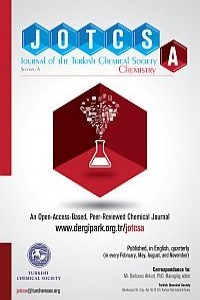Optical investigation of palladium(II) phthalocyanine including an aromatic group
Peripherally β-naphthoxy unit substituted palladium(II) phthalocyanine was synthesized from corresponding phthalonitrile compounds. The palladium (II) phthalocyanine was characterized with ultraviolet–visible spectroscopy (UV-Vis), fourier transform- infrared spectroscopy (FT-IR), mass and elemental analyses techniques. Thin films of palladium (II) phthalocyanine were prepared using different organic solvents by spin coating technique. Transmittance and absorbance spectra of the thin films were studied in the wavelength range of 200–1000 nm. Optical band gaps of palladium (II) phthalocyanine thin films were also calculated.
Keywords:
Phthalocyanine, β-naphthol, palladium thin film, optical properties,
___
- 1. McKeown NB. Phthalocyanine Materials: materials: synthesis, structure, and function. Cambridge University Press: Cambridge, 1998.
- 2. Leznoff CC, Lever ABP. Phthalocyanines: properties and applications. vols. 1–4. Eds. VCH Publishers: New York, USA, 1989.
- 3. Özçeşmeci İ, Güner S, Okur Aİ, Gül A. New phthalocyanines containing bulky electron rich substituents. J. Porphyrins Phthalocyanines. 2007; 11(07): 531–6.
- 4. Kurt Ö, Özçesmeci İ, Gül A, Koçak MB. Synthesis and photophysical properties of novel hexadeca-substituted phthalocyanines bearing three different groups. J. Organomet. Chem. 2014; 754: 8–15.
- 5. Seshan K. Handbook of Thin-Film Deposition Processes And Techniques, W. Andrew Publishing: Norwich, New York, U.S.A., 2002.
- 6. Özçesmeci İ, Sorar İ, Gül A. Optical studies on phthalocyanines substituted with phenylazonaphthoxy groups. Philos. Mag. 2016; 96(28): 2986–99.
- 7. Özçeşmeci M, Sorar İ, Hamuryudan E. Synthesis, optical and structural studies of tetrakis [4-(2′, 3′, 4′, 5′, 6′-pentafluorobenzyloxy) benzyloxy]-substituted metallo-phthalocyanines. Synth. Met. 2012; 162: 154–61.
- 8. Sorar İ, Şener MK, Tepehan F, Gül A. Structural and optical studies of tetra (tricarbethoxy)-substituted metallophthalocyanines. Thin Solid Films. 2008; 516: 2894–98.
- 9. Özçesmeci İ, Sorar İ, Gül A. Zinc (II) phthalocyanine as an optical window for visible region. Inorg. Chem. Commun. 2011; 14: 1254–57.
- 10. Young JG, Onyebuagu WJ. Synthesis and Characterization of Di-disubstituted Phthalocyanines, Org. Chem. 1990; 55: 2155–59.
- 11. Yenilmez HY, Özçeşmeci İ, Okur Aİ, Gül A. Synthesis and characterization of metal-free and metallophthalocyanines with four pendant naphthoxy-substituents. Polyhedron. 2004; 23: 787–91.
- 12. Özçeşmeci M. Synthesis, photophysical and photochemical properties of metal-free and zinc (II) phthalocyanines bearing α-naphtholbenzein units. J. Organomet. Chem. 2014; 767: 16–21.
- 13. Özçeşmeci İ, Yerli Y, Okur Aİ, Gül A. Synthesis and EPR studies of a near infrared absorbing tetrakis(2-naphthoxy)vanadyl-phthalocyanine. Inorg. Chem. Commun. 2009; 12: 625–27.
- 14. Hanack M, Schmid G, Sommeraner M, Chromatographic separation of the four possible structural isomers of a tetrasubstituted phthalocyanine: tetrakis(2-ethylhexyloxy)phthalocyaninatonickel(II). Angew. Chem. Int. Ed. Engl. 1993; 32 (10): 1422–24.
- 15. Özçesmeci İ, Koca A, Gül A. Synthesis and electrochemical and in situ spectroelectrochemical characterization of manganese, vanadyl, and cobalt phthalocyanines with 2-naphthoxy substituents. Electrochim. Acta. 2011; 56: 5102–14.
- 16. Tauc J, Grigorovici R, Vancu A, Optical properties and electronic structure of amorphous germanium. Phys. Status Solidi. 1966; 15: 627-37.
- Başlangıç: 2014
- Yayıncı: Türkiye Kimya Derneği
Sayıdaki Diğer Makaleler
NANO ZINC BORATE AS A LUBRICANT ADDITIVE
Sevdiye Atakul Savrık, Burcu Alp, Fatma Üstün, Devrim Balköse
Berna TOPUZ, Ali Semih YURTTAS, Ali ALTUNSOY
Youssef MERROUN, Soukaina CHEHAB, Touriya GHAILANE, Said BOUKHRIS, Rachida GHAILANE, Nouzha HABBADI, Amina HASSIKOU, Brahim LAKHRISSI, Abdelaziz SOUIZI
Fehime Çakıcıoğlu-Özkan, Yasemin Erten-Kaya
Metin Yurddaskal, Serdar Yıldırım, Tuncay Dikici, Melis Yurddaskal, Mustafa Erol, İdil Aritman, Erdal Çelik
Atakan Toprak, Kadriye BOZGEYİK
Masahiro Mikuriya, Chihiro Yamakawa, Kensuke TANABE, Daisuke YOSHİOKA, Ryoji MİTSUHASHİ, Hidekazu TANAKA, Makoto HANDA
